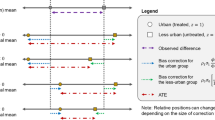Abstract
Consider a firm providing home-delivery of small parcels within a short period of time. The paper proposes a method to estimate the productivity of each driver on any fictitious route using linear regressions. The method separates the trip time in terms of the time spent: with customers, driving, and all other activities. Our tests show that productivity, measured in terms of number of customers visited per hour, vary across drivers. Even more, the same driver’s productivity vary for peak and off-peak demand periods considerably. This methodology should enhance the reliability of the driver scheduling programs, since it reduces the error and bias of the productivity offered by the assigned set of drivers. It shall also improve the reliability of the delivery time promised to the customer.
Similar content being viewed by others
References
Barnhart, C., & Shenoi, R. J. (1998). An approximate model and solution approach for the long-haul crew pairing problem. Transportation Science, 32, 221–231.
Brusco, M. J., Jacobs, J. W., Bongiorno, R. J., Lyons, D. V., & Tang, B. (1995). Improving personnel scheduling at airline stations. Operations Research, 43, 741–751.
Caprara, A., Toth, P., Vigo, D., & Fischetti, M. (1998). Modeling and solving the crew rostering problem. Operations Research, 46, 820–830.
Daganzo, C. F. (2005). Logistics systems análisis (4th ed.). Heidelberg: Springer.
Gamache, M., Soumis, F., Villeneuve, D., Desrosiers, J., & Gélinas, E. (1998). The preferential bidding system at air Canada. Transportation Science, 32, 246–255.
Gamache, M., Soumis, F., Marquis, G., & Desrosiers, J. (1999). A column generation approach for large-scale aircrew rostering problems. Operations Research, 47, 247–262.
Klajban, D., Johnson, E. L., Nemhauser, G. L., Gelman, E., & Ramswamy, S. (2001). Airline crew scheduling with regularity. Transportation Science, 35, 359–374.
Klajban, D., Johnson, E. L., Nemhauser, G. L., Gelman, E., & Ramswamy, S. (2002). Airline crew scheduling with time windows and plane-count constraints. Transportation Science, 36, 337–348.
Lourenço, H. R., Paixao, J. P., & Portugal, R. (2001). Multiobjective metaheuristics for the bus-driver scheduling problem. Transportation Science, 35, 331–343.
Muñoz, J. C. 2002. Crew-shift design for transportation systems with uncertain demand. Ph.D. thesis, Department of Civil and Environmental Engineering, University of California, Berkeley, CA.
Ortúzar, J. de D. (2000). Modelos econométricos de elección discreta. Santiago: Ediciones Universidad Católica de Chile (in Spanish).
Sage, D. (2001). Express delivery. In A. Brewer (Ed.), Handbook of logistics and supply chain management (pp. 455–466). Amsterdam: Elsevier.
Vance, P. H., Barnhart, C., Johnson, E. L., & Nemhauser, G. (1997). Airline crew scheduling: a new formulation and decomposition algorithm. Operations Research, 45, 188–200.
Author information
Authors and Affiliations
Corresponding author
Rights and permissions
About this article
Cite this article
Genta, S., Muñoz, J.C. On assigning drivers for a home-delivery system on a performance basis. Ann Oper Res 155, 107–117 (2007). https://doi.org/10.1007/s10479-007-0201-5
Published:
Issue Date:
DOI: https://doi.org/10.1007/s10479-007-0201-5




